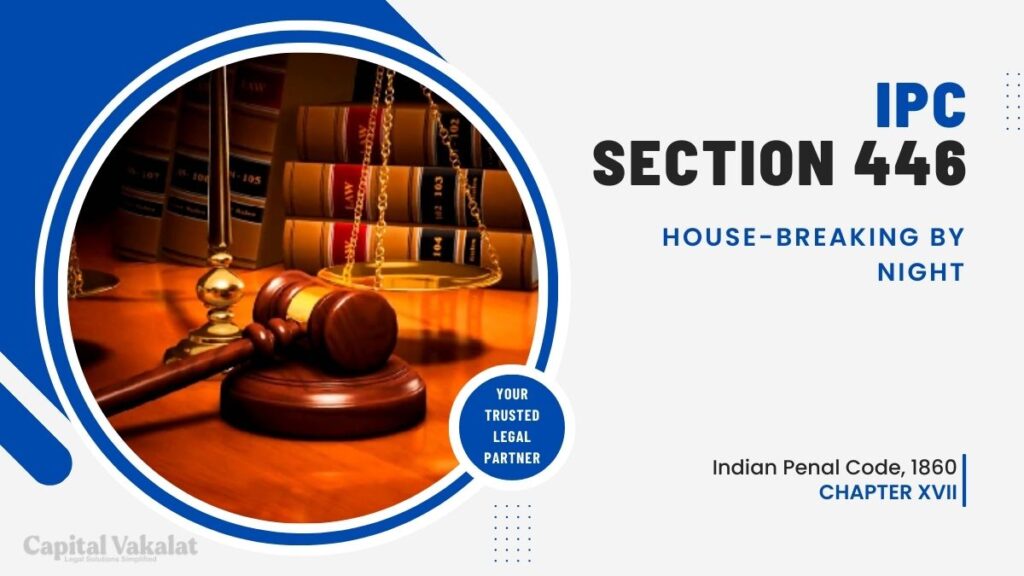In the vast legal landscape of the Indian Penal Code (IPC), Section 446 holds a distinct place, dealing specifically with the act of house-breaking by night. This provision aims to safeguard the sanctity of one’s dwelling during the vulnerable hours of darkness.

Let’s delve into the intricacies of Section 446 IPC, understanding its historical evolution, legal implications, challenges, and preventive measures.
Historical Context
To comprehend the essence of Section 446 IPC, it’s essential to explore its historical roots. The provision has its origins deeply embedded in the societal need to protect personal spaces from intrusion, a concern dating back centuries. As laws evolved, so did the need to address the nuances of criminal activities, leading to the formulation of dedicated sections like 446.
Elements of Section 446 IPC
Breaking into a dwelling during the night constitutes a primary element of Section 446 IPC. The provision specifically targets activities that occur under the cover of darkness, recognizing the heightened risk and potential harm associated with nighttime intrusion. Intent and purpose behind such actions are crucial factors, distinguishing ordinary trespass from the offense outlined in this section.
Legal Consequences
Understanding the legal repercussions is paramount. Offenders caught under Section 446 IPC face penalties that range from fines to imprisonment. Real-world case studies serve as poignant examples, shedding light on the practical application of the law and its impact on individuals involved.
Challenges and Controversies
No legal provision is without its challenges. Interpretation issues, debates on the severity of punishments, and criticisms of potential loopholes are common controversies surrounding Section 446 IPC. Navigating through these debates offers insight into the dynamics of the legal system.
Preventive Measures
Beyond legal consequences, prevention is key. Homeowners can take proactive measures to safeguard their residences. From traditional security practices to modern technological solutions, the arsenal against house-breaking by night is diverse. A closer look at effective preventive measures helps communities build resilience.
Impact on Victims
The aftermath of a house-breaking incident goes beyond physical losses. Victims often grapple with psychological trauma. Exploring the emotional toll and discussing coping mechanisms shines a light on the human aspect of this legal provision.
Comparison with Similar Provisions
Section 446 IPC doesn’t exist in isolation. Contrasting it with other sections within the IPC and examining international counterparts provides a comprehensive view. Understanding how different legal systems address similar offenses offers valuable insights for potential reforms.
Reform and Amendments
Laws are not static; they evolve with societal changes. Section 446 IPC has undergone modifications in the past, and ongoing discussions about potential reforms are noteworthy. Analyzing the need for change and the direction of proposed amendments contributes to a forward-looking perspective.
Conclusion
In conclusion, Section 446 IPC plays a crucial role in maintaining the security of dwellings during nighttime hours. As we navigate the legal intricacies, it becomes evident that the provision is not just a set of rules but a reflection of societal values. In an era where security challenges evolve, a collective effort towards awareness, prevention, and legal reform is imperative.
Frequently Asked Questions
How can homeowners enhance their security against night-time intrusion?
Implementing security measures like robust locks, alarm systems, and proper lighting can significantly enhance home security.
Are there any notable legal precedents related to Section 446 IPC?
Yes, several cases have set legal precedents, influencing the interpretation and application of Section 446 IPC.
Does Section 446 IPC apply to all types of dwellings?
The provision generally applies to residential structures, but the legal interpretation may consider various factors.
Are there proposed amendments to Section 446 IPC in the near future?
Ongoing discussions suggest that lawmakers are considering amendments to address emerging challenges and enhance the effectiveness of the provision.